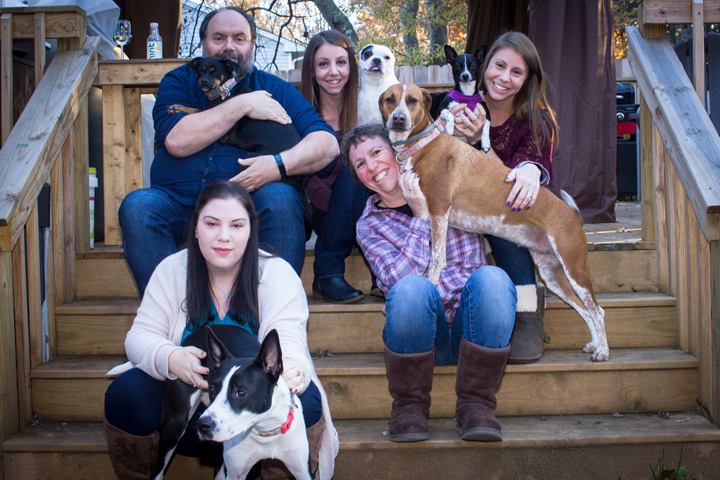The Butterfly Effect and Living Every Day to My Fullest

- Genetic testing after diagnosis shows BRCA2 mutation
- Treatment with FOLFIRINOX, followed by 5-FU and radiation
- Whipple procedure
- Recurrence in lung
- Clinical trial with PARP inhibitor
My name is Helene Avraham-Katz. I am a 58-year-old wife, mother to three wonderful daughters and two amazing dogs, but I am much more than that.
In October 2016, I received the horrifying and terrifying diagnosis that I had a stage IIA pancreatic head and neck non-resectable adenocarcinoma. I knew more than I ever wanted to about this awful disease, as my mom had passed away from it just over 10 years previously; her brother passed away from the same cancer in 2014.
I had been having pain in my upper abdomen and found that I could not eat much without feeling very full and uncomfortable. I was very fortunate to be referred to an amazing surgeon, Dr. Russell Howerton, at Wake Forest Baptist Hospital (Winston-Salem, North Carolina) about 30 minutes from our home in Greensboro. The news was not good. On one hand, we had caught the cancer early; it was still relatively small and had not spread. But it was in the worst position possible. It was in the head of my pancreas, attached to both a vein and an artery. The doctors could not cut both—it was too risky. Since my tumor was inoperable because of its position, my only chance was to have chemotherapy and radiation to aggressively try to shrink the tumor enough to be off either the vein or the artery. If they could do this, I had a chance at eligibility for the Whipple surgery.
Aiming for Surgery
I knew my uncle had tested positive for the BRCA2 mutation so my incredible oncologist, Dr. Steven Sorscher, explained how important it was to know if I carried the mutation. After testing positive for BRCA2, he encouraged me to go with a combination of four chemotherapies called FOLFIRINOX. I responded very well to this chemo and my CA 19-9 went down significantly. After finishing with the chemo, I began a 29-day course of radiation with continuous 5-FU chemotherapy administered via a pump. The scan a few weeks after my radiation concluded showed that my tumor had shrunk, but it was still not clear that I would be eligible for surgery.
From the first day that I was diagnosed, my wonderful husband and three adult daughters made the decision that we were not going to let this beat us and we were going to fight as hard as we could. We were all extremely positive and did not allow it to get us down. I lost six pounds after my first round of chemotherapy, and then my husband said it was enough. He is a great cook and started cooking organically for me, cutting my food, and then watching me eat to make sure I did not feed the dogs! He is very dramatic, and it was easier to eat than argue! I never lost another pound through chemo and radiation/chemo. I also walked at least a mile every weekend while going through radiation, at least when the 5-FU pump was off. I was very fortunate to be working from home at the time and worked as much as I could, which really helped me. I had a reason to get off the couch and something positive to do.
Because I had tolerated the treatment so well, and my CA 19-9 was in the normal range, my surgeon supported my request to present my case to the tumor board and get their okay to proceed with an exploratory surgery to see if they could perform a Whipple. Fortunately, the tumor board gave the okay to the surgery in June 2017. They removed my entire pancreas, so I now have type 1 diabetes and have to take enzymes when I eat, but that is a small price to pay for my life.
A Clinical Trial After Recurrence
I was clear of cancer for a year after my surgery. I chose not to do any further chemotherapy treatments during this period but went for regular blood work every six weeks and a scan every three months. Just over a year after my surgery, during a regular blood test and scan, we learned that my cancer had come back in my lung. I went for a lung resection which confirmed this. Before starting chemo again, my oncologist recommended that I try and find a test study. I spent hours researching and eventually, thanks to Let’s Win, found a clinical trial at the Abramson Cancer Center at University of Pennsylvania (Philadelphia). After speaking with Dr. Kim Reiss Binder, the oncologist in charge, I knew that she was the doctor I wanted to work with.
I first went through another four rounds of FOLFOX chemotherapy (I developed a reaction to irinotecan during my first treatment) before meeting with Dr. Reiss Binder in October of 2018 and starting on the program. I now take six pills a day called PARP inhibitors (Rucaparib) and am doing really well on this regimen.
I initially went to Philadelphia every four weeks, and after a couple of years, it went up to every eight weeks and recently every 12 weeks. There is no charge for the treatments, but I have to pay for all my travel expenses. Due to Covid, I have been meeting with Dr. Reiss Binder online rather than having to travel, which has been very helpful financially.
My Life Takes a New Turn
I am doing very well on the program and in October of 2019, I opened a new store called The Butterfly Effect, featuring the work of local artisans. I work extremely full-time and make every effort to live every day to the fullest! During Covid, while my store was closed, I wrote a book about my story, also called The Butterfly Effect, which can be found on my website.
Helene passed away after a seven-year struggle with pancreatic cancer. She proclaimed she was not a statistic and focused on living her life to the fullest. We offer our deepest sympathy to her family.
Watch Helene tell her story in “Breathe Happy.”






